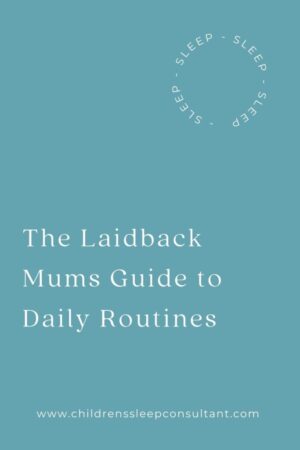The Laidback Mums Guide to Daily Routines
Routine is important for humans. Even if you don’t think you stick to a daily routine, the chances are you have some routines. You probably eat 3 meals a day (more than likely around the same time each day), go to bed around the same time and get up at the same time each day.
Many people worry that getting your child on a routine will be too restrictive, and you’ll have to be at home all day. Never to leave the house anywhere near nap time!
This isn’t the case. Your routine can be as structured as you want it to be.

Here’s my guide to daily routines for laidback mums.
Having an awake window in the morning.
If your child gets up around the same time each day, naps are around the same time, and bedtime will be around the same time. Lots of us want a consistent bedtime. The more consistent the day, the more consistent your bedtime will be. Let me explain why…
Children will want to sleep around the same amount of hours after they get up in the morning. Therefore, if your child sleeps an extra hour in the morning, their morning nap will be an hour late, as will their afternoon nap, as will bedtime! The following morning, your wake-up time may be later. This may not be such a bad thing, but chances are, this will happen again and again and before you know it, your child is getting up at 10 am (how lovely) but not going down to sleep until 10 pm!
I don’t like to have a strict awake time in the morning, but an awake window. This window is your awake time in the morning. Half an hour is a perfect awake window. Anything before this window is still night, and if your child is still sleeping at the end of the awake window, you will want to wake them gently.
Sleep times should be around the same time daily.
When your child is going to sleep (both during the day and at night) at around the same time, their circadian rhythm is regulated. This means that your child will begin to get sleepy at the same time each day making it easier for them to fall asleep. You also know they will be ready for sleep and avoid tiredness.
Meal times should be around the same time daily.
Much like sleep, where we get tired around the same time each day when we eat around the same time each day, we get hungry at around the same time. Eating around the same time avoids hangry children!
Before-bed routines are equally important.
It’s hard for children, no matter how young, to go from playing to sleep in a matter of minutes. (There are some children who will sleep anywhere whilst doing anything, this usually depends on your child’s temperament, you can find out more about how temperament effects sleep HERE), but the majority of children need some help winding down and getting ready for sleep.
Nap routine
A nap routine needs to be between 10 and 15 minutes long to be really effective. You want to go into your child’s room (or the room where they sleep) and do the same thing in the same order whenever you are at home.
For example:
- Go into your child’s room and close the shades.
- Sit down together and read a book or two or three. (You may want to finish with the same book each time. That way, your child will know when books are over.
- Sing a song or two.
- Help to sleep.
As your child gets more and more used to this routine, they will begin to unwind and relax as soon as you get started.
Night routine
You want your nighttime routine to be between 30 and 45 minutes. 30 minutes if you don’t give your child a bath. Around 45 minutes if you do give them a bath.
Much like your nap routine, you want it to be predictable. Do the same thing in the same order.
For example:
- Bath (if you have one at his time.)
- Into jammies. (12 months + let your toddler choose their jammies.)
- Milk and brush teeth.
- Read books, finishing with the same book each time. (12 months + let your toddler choose the books.)
- Sing songs. (12 months + let your toddler choose the songs.)
- Quick snuggle.
- Into bed
It’s important to keep things relaxed, quiet and calm before you start your bedtime routine. A relaxed and calm child will have a far easier time falling asleep.
You can always shorten your nap or night routine if your child seems very tired once you get started. Keep your routines consistent, just make each step a little shorter. That way, your sleep routines remain consistent.
Don’t feel that routines need to be restrictive, they can make sleep much easier and give you more freedom.



